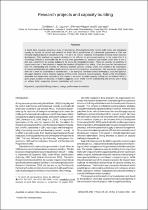JavaScript is disabled for your browser. Some features of this site may not work without it.
- ResearchSpace
- →
- Research Publications/Outputs
- →
- Journal Articles
- →
- View Item
| dc.contributor.author |
Breen, CM

|
en_US |
| dc.contributor.author |
Jaganyi, JJ

|
en_US |
| dc.contributor.author |
Van Wilgen, BW

|
en_US |
| dc.contributor.author |
Van Wyk, E

|
en_US |
| dc.date.accessioned | 2007-03-16T06:59:16Z | en_US |
| dc.date.accessioned | 2007-06-07T10:05:56Z | |
| dc.date.available | 2007-03-16T06:59:16Z | en_US |
| dc.date.available | 2007-06-07T10:05:56Z | |
| dc.date.issued | 2004-10 | en_US |
| dc.identifier.citation | Breen, CM, et al. 2004. Research projects and capacity building. Water SA, vol. 30(4), pp 429-434 | en_US |
| dc.identifier.issn | 0378-4738 | en_US |
| dc.identifier.uri | http://hdl.handle.net/10204/1956 | en_US |
| dc.identifier.uri | http://hdl.handle.net/10204/1956 | |
| dc.description.abstract | A World Bank long-term perspective study on Sub-Saharan Africa highlighted the need to build human and institutional capacity in virtually all sectors and countries. In South Africa, establishment of a democratic government in 1994 saw increased emphasis placed on capacity building. This led to the revision of policies and legislation directing human resources development. This emphasis on capacity development is reflected in procurement policies to the extent that it is increasingly difficult to successfully bid for funding from government and parastatal organisations unless there is both a plan and a commitment to capacity building in the previously marginalised sectors. There are currently no guidelines to support researchers in their attempts to support the intentions of legislation and policy. It has been assumed that researchers have the understanding and expertise to effectively promote capacity building. Under such conditions the expectations of research administrators are neither clearly structured nor are they understood by researchers. Not surprisingly, researchers often fail to meet the expectations of administrators. In an attempt to contribute towards developing a structured approach, this paper interprets what is meant by capacity building in the context of research projects. Based on this interpretation, reasonable and unreasonable expectations with respect to the extent to which capacity building can be achieved within a given project duration are discussed. A model is suggested, which would improve understanding and delivery and in doing so, achieve better congruence between expectations and outcomes. | en_US |
| dc.format.extent | 53804 bytes | en_US |
| dc.format.mimetype | application/pdf | en_US |
| dc.language.iso | en | en_US |
| dc.publisher | Water Research Commission | en_US |
| dc.rights | Copyright: 2004 Water Research Commission | en_US |
| dc.subject | World Bank | en_US |
| dc.subject | Capacity building | en_US |
| dc.subject | Research projects | en_US |
| dc.subject | Change initiatives | en_US |
| dc.subject | Human development | en_US |
| dc.subject | Social sciences | en_US |
| dc.title | Research projects and capacity building | en_US |
| dc.type | Article | en_US |
| dc.identifier.apacitation | Breen, C., Jaganyi, J., Van Wilgen, B., & Van Wyk, E. (2004). Research projects and capacity building. http://hdl.handle.net/10204/1956 | en_ZA |
| dc.identifier.chicagocitation | Breen, CM, JJ Jaganyi, BW Van Wilgen, and E Van Wyk "Research projects and capacity building." (2004) http://hdl.handle.net/10204/1956 | en_ZA |
| dc.identifier.vancouvercitation | Breen C, Jaganyi J, Van Wilgen B, Van Wyk E. Research projects and capacity building. 2004; http://hdl.handle.net/10204/1956. | en_ZA |
| dc.identifier.ris | TY - Article AU - Breen, CM AU - Jaganyi, JJ AU - Van Wilgen, BW AU - Van Wyk, E AB - A World Bank long-term perspective study on Sub-Saharan Africa highlighted the need to build human and institutional capacity in virtually all sectors and countries. In South Africa, establishment of a democratic government in 1994 saw increased emphasis placed on capacity building. This led to the revision of policies and legislation directing human resources development. This emphasis on capacity development is reflected in procurement policies to the extent that it is increasingly difficult to successfully bid for funding from government and parastatal organisations unless there is both a plan and a commitment to capacity building in the previously marginalised sectors. There are currently no guidelines to support researchers in their attempts to support the intentions of legislation and policy. It has been assumed that researchers have the understanding and expertise to effectively promote capacity building. Under such conditions the expectations of research administrators are neither clearly structured nor are they understood by researchers. Not surprisingly, researchers often fail to meet the expectations of administrators. In an attempt to contribute towards developing a structured approach, this paper interprets what is meant by capacity building in the context of research projects. Based on this interpretation, reasonable and unreasonable expectations with respect to the extent to which capacity building can be achieved within a given project duration are discussed. A model is suggested, which would improve understanding and delivery and in doing so, achieve better congruence between expectations and outcomes. DA - 2004-10 DB - ResearchSpace DP - CSIR KW - World Bank KW - Capacity building KW - Research projects KW - Change initiatives KW - Human development KW - Social sciences LK - https://researchspace.csir.co.za PY - 2004 SM - 0378-4738 T1 - Research projects and capacity building TI - Research projects and capacity building UR - http://hdl.handle.net/10204/1956 ER - | en_ZA |






